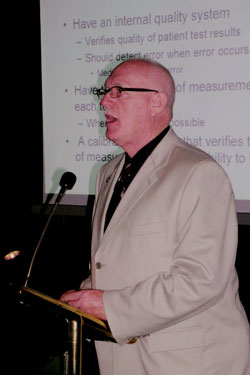ISO
ISO 15189 QSE 5.6: Assuring the Quality of Examination Procedures
Greg Cooper of Bio-Rad gave a presentation on how ISO 15189 applies to clinical laboratories.
October 2005
 In January 2003, the International Organization for Standardization (ISO) published the world’s first harmonized clinical laboratory practice standard. Laboratories who wished to have some verification of their quality and performance have for years used ISO 17025 – General requirements for the competence of calibration and testing laboratories. While this certification standard certainly provided a framework for a laboratory quality system, many of its requirements, relative to clinical laboratories, were either inappropriate for clinical laboratory application or missing. Consequently, the laboratory community approached the ISO Secretariat about creating a standard specifically for the unique requirements of clinical laboratory practice. The standard that was published is known as ISO 15189 Medical laboratories – Particular requirements for quality and competence. Known more commonly as ISO 15189, this standard since its publication has gained rapid and widespread acknowledgement and adoption as an accreditation standard in many countries.
In January 2003, the International Organization for Standardization (ISO) published the world’s first harmonized clinical laboratory practice standard. Laboratories who wished to have some verification of their quality and performance have for years used ISO 17025 – General requirements for the competence of calibration and testing laboratories. While this certification standard certainly provided a framework for a laboratory quality system, many of its requirements, relative to clinical laboratories, were either inappropriate for clinical laboratory application or missing. Consequently, the laboratory community approached the ISO Secretariat about creating a standard specifically for the unique requirements of clinical laboratory practice. The standard that was published is known as ISO 15189 Medical laboratories – Particular requirements for quality and competence. Known more commonly as ISO 15189, this standard since its publication has gained rapid and widespread acknowledgement and adoption as an accreditation standard in many countries.
There is considerable interest among laboratories in India about ISO 15189. Medical tourism and opportunities to work on clinical trials for pharmacology companies is driving some of this interest and as leading laboratories begin to accredit their operations to the ISO 15189 standard, other laboratories will follow suit in order to compete. Those of us involved with the Bio-Rad QC meet this year in Mumbai, Chennai, Kolkatta and Delhi and last year feel as though we have personally met with many of the leading laboratories and laboratory professionals in India. We were honored to visit two of these laboratories during our travels - Calcutta Medical Research Institute where we met Dr T.K. Gosh, Ms Bina and their team of enthusiastic and quality conscious personnel and Dr Lal Path Labs - Delhi where we met Dr Arvind Lal and Dr Puneet Nigam.
The most unique aspect of ISO 15189 is also the most challenging for many laboratories and that is the construct of a quality system. Many laboratories have no concept of how to build, implement and maintain a quality system. At last year’s Bio-Rad QC meet in India, general requirements for building a quality system were covered. At this year’s meet, focus was given to the quality documents that form the framework of the quality system; namely, policies, processes and procedures. Policies specify intent and direction and are general in content. Processes are somewhat more specific and transform the intent of the policy into action identifying individuals responsible for transforming the intent of the policy. Laboratories are most familiar with procedures as these documents describe how to perform some specific task.
This year’s presentation, provided here as a courtesy by Dr. Westgard, was intended to give laboratories some examples of policies and processes designed to meet requirements for ISO 15189 Section 5.6 (Assuring the quality of the examination procedure). These examples are intended to give laboratories an idea of what forms a policy and process might take relative to quality control. These examples might also be used directly if the laboratory so chooses. The presentation was also based on mapping the path of workflow for Section 5.6 from selection/design of the QC paradigm to reporting the patient test result. All paths of workflow should end with the patient either directly or indirectly because the patient’s health and well-being defines our purpose in clinical laboratory medicine.
Greg Cooper's presentation is available in the Downloads section of this website.
